




Your support is critical to our success.
Accepted Scientific Name: Euphorbia gymnocalycioides M.G.Gilbert & S.Carter
Bradleya 2: 9 (1984).
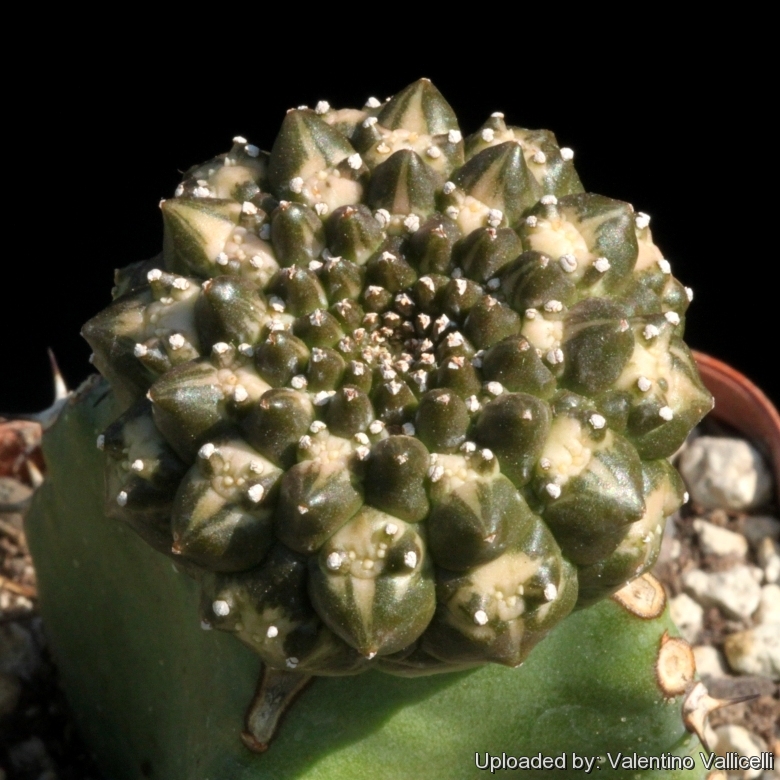
Origin and Habitat: Garden origin.
Synonyms:
Euphorbia gymnocalycioides M.G.Gilbert & S.Carter
Bradleya 2: 9 (1984).
Synonymy: 2
- Euphorbia gymnocalycioides M.G.Gilbert & S.Carter
- Euphorbia gymnocalycioides f. variegata hort.
Description: Euphorbia gymnocalycioidesSN|23033]]SN|14187]] is a great looking small succulent euphorbia with a deep green, knobby globoid body. It bears such a striking similarity to a genus in the cactus family, Gymnocalycium, that it was given the epithet "gymnocalycioides" (resembling Gymnocalycium). It is a fine example of convergent evolution, a process in which the same adaptive traits evolve in distantly related species or groups as a response to similar environments (in this case, hot and dry deserts).
Forma variegata (variegated form): The "variegated form" (Euphorbia gymnocalycioides f. variegataSN|14187]]SN|23033]]) is distinguished from the standard species by its tubercles that shows cream or pale-green patches or zones at the base and in the adaxial face of tubercles. The colour of variegated parts varies depending on sun exposure and season. This variegated plants come true from seed and are particularly priced by collectors. For all other characteristics it is comparable to the standard dark green from.
Stem: Fattened globular, subglobular to shortly cylindrical, up to 12 tall x 10 cm wide, bluish-green, that can take a dark tan to purplish tinge in full sun.
Tubercles: Prominent, separated by deep grooves, approx 1 cm apart, with a striking spiral arrangement in approx 18 series. Each tubercle is tipped by a weakly horny shield up to 2,5 mm in diameter bearing the leaves scars. A more or less evident variegation (cream or pale-green patches or zones) is visible at the base and in the adaxial face of tubercles.
Spines: Minute only in the seedlings and on the new growth.
Leaves: Rudimentary, ephemeral and quickly deciduous.
Roots: 1,5 cm thick and merging into the body.
Flowers: Small around the growth centre. The inflorescences are simple (or occasionally branched) cymes, consisting of three cyathia, which appear in groups of 2 to 6 on each eye, but not all developing. Often in young plants with only the central of the three cyathia developed. Peduncle up to 7,5 mm, cyathia 2,5 mm in diameter, elliptic, brown, pedicel 2,5 mm.
Blooming season: Summer.
Subspecies, varieties, forms and cultivars of plants belonging to the Euphorbia gymnocalycioides group
 Euphorbia gymnocalycioides M.G.Gilbert & S.Carter: is a small succulent euphorbia with a deep green, knobby globoid body that bears similarity to a genus in the cactus family, Gymnocalycium. Distibution: Southern Ethiopia (Sidamo prov.)
Euphorbia gymnocalycioides M.G.Gilbert & S.Carter: is a small succulent euphorbia with a deep green, knobby globoid body that bears similarity to a genus in the cactus family, Gymnocalycium. Distibution: Southern Ethiopia (Sidamo prov.) Euphorbia gymnocalycioides f. variegata hort.: Has cream or pale-green patches or zones at the base and in the adaxial face of tubercles. For all other characteristics it is comparable to the standard dark green from.
Euphorbia gymnocalycioides f. variegata hort.: Has cream or pale-green patches or zones at the base and in the adaxial face of tubercles. For all other characteristics it is comparable to the standard dark green from.
Notes: Variegation, albinism & schizochromism.
Variegation: A variegated plant has sectors, patches or stripes with two or more different colours, even distinct shades of green. Plants with variegated stems or leaves are often attractive and highly prized. In most species the stems or leaves are normally green, and variegated epidermis is an uncommon mutation, termed a chimera. A chimeral variegation is due to losing the ability to produce chlorophyll in some of the plant’s tissue, so that this tissue is no longer green. Tissues lacking chlorophyll are usually white or pale yellow coloured (due to carotenoid pigments) or red (due to betalain or anthocyanin pigments) contrasting with the normal green tissue. There are several forms of variegation, depending on the tissues that have been affected. The variegation in some forms is unstable. The extent and nature of the variegation can vary, and sometimes the plant will return to the green form. In others it is stable and does not change under normal conditions. Because the variegation is due to the presence of two kinds of plant tissue, propagating the plant must be by a vegetative method of propagation that preserves both types of tissue in relation to each other.
Albinism: Every once in a while a plant exhibits albinism (completely lacking chlorophyll pigment). This means that its tissue is unable to carry out photosynthesis. The result is a completely cream-white plant. This plant will be weaker than a green plant, and albinism is generally a fatal trait (it can't produce its own food and it's not getting it from anything else). Without chlorophyll, the albino plant has no way to manufacture the food needed for survival and growth to maturity. This implies that these plants cannot survive on their own roots and necessitate being grafted on a normal green plant that provides food. Some of these albino plants are indeed very popular, and sought after by collectors.
Schizochromism: The yellow or red appearance of some plants is more precisely caused by another aberration called "schizochromism". Here, though, the specific green pigment (chlorophyll) is missing: every other pigment is present at normal levels. The dominant green colouration is lost, but the plant will still more than likely have normal other pigments that give the yellow or red overall appearance of stems and leaves.
Bibliography: Major references and further lectures.
1) Urs Eggli “Illustrated Handbook of Succulent Plants: Dicotyledons” Springer Science & Business Media, 2002
2) Doreen Court “Succulent Flora of Southern Africa” CRC Press, 01/Jun/2000
3) Urs Eggli, Leonard E. Newton "Etymological Dictionary of Succulent Plant Names" Springer Science & Business Media, 29 June 2013
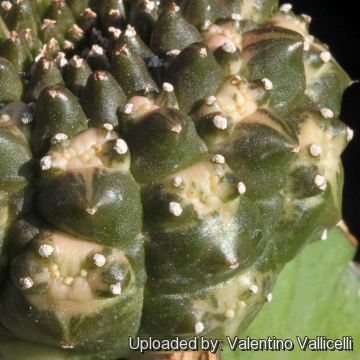
Euphorbia gymnocalycioides f. variegata Photo by: Valentino Vallicelli
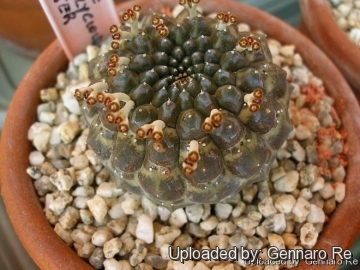
Euphorbia gymnocalycioides f. variegata Photo by: Gennaro Re
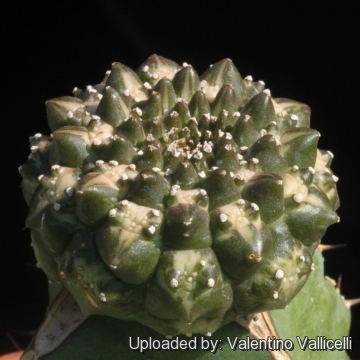
Euphorbia gymnocalycioides f. variegata Photo by: Valentino Vallicelli
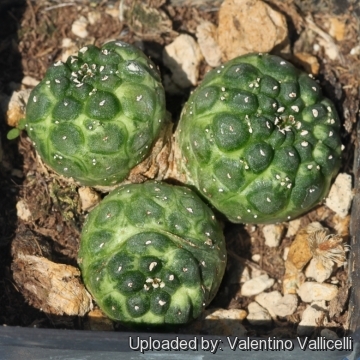
Euphorbia gymnocalycioides f. variegata Photo by: Valentino Vallicelli
Cultivation and Propagation: The variegated Euphorbia gymnocalycioidesSN|16003]]SN|14187]] comes true from seed, but it is often grafted for convenience on Euphorbia canariensisSN|15754]]SN|15754]] or Euphorbia resiniferaSN|14187]]SN|16003]].
Frost Tolerance: Need frost protection.
Sun Exposure: Light shade.
Propagation: Seeds or grafting. The plants that are grafted on a more vigorous and easier stocks are easier to keep and grow faster. The method of grafting euphorbias differs little from that of other succulents, except in one important aspect. The latex must be washed or sprayed off until hardly anything remains. After the latex flow has stopped, a further 1-2 mm slice can be taken from both surfaces without a new latex flow starting. Both scion and stock need to be at the start of the growing season. The stock should be cut as near as possible to the growing tip, as here the vascular bundles are dense and not yet woody and will feed the scion in the best possible way. Where possible stock and scion should be of similar diameter. The cut surfaces are held together with elastic bands in cross style, over the plant top and under the pot. The plants should be left in an airy and shady place for 7-10 days before the bands are removed.
Warning: As with all other Euphorbias when a plant get damaged it exudes a thick white milky sap known as latex. This latex is poisonous and particularly dangerous for the eyes, skin and mucous membranes. So pay extreme attention not to get any in your eyes or mouth. Cultivated plants must be handled carefully.
| Your Actions | |
|---|---|
| Back to Euphorbia index | |
| Back to Euphorbiaceae index | |
 |
Back to Succulents Encyclopedia index |
Privacy stantement - Terms and conditions - How to cite - About us - Feedback - Donate



